 | | | Switch to: Europe, USA, New Zealand, Antarctica Credit: NOAA/Ovation  Planetary K-index Planetary K-index
Now: Kp= 2 quiet
24-hr max: Kp= 2 quiet
explanation | more data
Interplanetary Mag. Field
Btotal: 5.0 nT
Bz: 2.3 nT north
more data: ACE, DSCOVR
Updated: Today at 2346 UT  Coronal Holes: 23 Sep 17 Coronal Holes: 23 Sep 17 
Solar wind flowing from this coronal hole should reach Earth on Sep. 23-24. Credit: NASA/SDO.  Noctilucent Clouds Latest images from NASA's AIM spacecraft show that the 2017 northern summer season for noctilucent clouds has finished. Switch view: Europe, USA, Asia, Polar Updated at: 09-03-2017 01:55:03 Noctilucent Clouds Latest images from NASA's AIM spacecraft show that the 2017 northern summer season for noctilucent clouds has finished. Switch view: Europe, USA, Asia, Polar Updated at: 09-03-2017 01:55:03  SPACE WEATHER
NOAA Forecasts | | Updated at: 2017 Sep 24 2200 UTC FLARE | 0-24 hr | 24-48 hr | CLASS M | 15 % | 15 % | CLASS X | 01 % | 01 % |  Geomagnetic Storms: Geomagnetic Storms:
Probabilities for significant disturbances in Earth's magnetic field are given for three activity levels: active, minor storm, severe storm Updated at: 2017 Sep 24 2200 UTC Mid-latitudes | 0-24 hr | 24-48 hr | ACTIVE | 30 % | 15 % | MINOR | 15 % | 05 % | SEVERE | 01 % | 01 % | High latitudes | 0-24 hr | 24-48 hr | ACTIVE | 15 % | 15 % | MINOR | 25 % | 25 % | SEVERE | 50 % | 25 % | | | |  | | | | | | | | | | | Lights Over Lapland is excited to announce that our Customizable Aurora Adventures are available for immediate booking! Reserve your adventure of a lifetime in Abisko National Park, Sweden today! | | | CO-ROTATING INTERACTION REGION: NOAA forecasters estimate a 40% chance of polar geomagnetic storms on Sept. 24th when a co-rotating interaction region (CIR) is expected to hit Earth's magnetic field. CIRs are transition zones between slow- and fast-moving solar wind streams. Solar wind plasma piles up in these regions, producing density gradients and shock waves that do a good job of sparking auroras. Free: Aurora Alerts A POTENT SUNSPOT IN THE OFFING? In early September, monster sunspot AR2673 emerged with shocking speed and proceeded to unleash a pair of decade-class solar flares. The resulting severe geomagnetic storms sparked Northern Lights in the USA as far south as Arkansas on Sept. 8th. Now, the sunspot is coming back. The bright loops in this photo from NASA Solar Dynamics Observatory herald its approach: 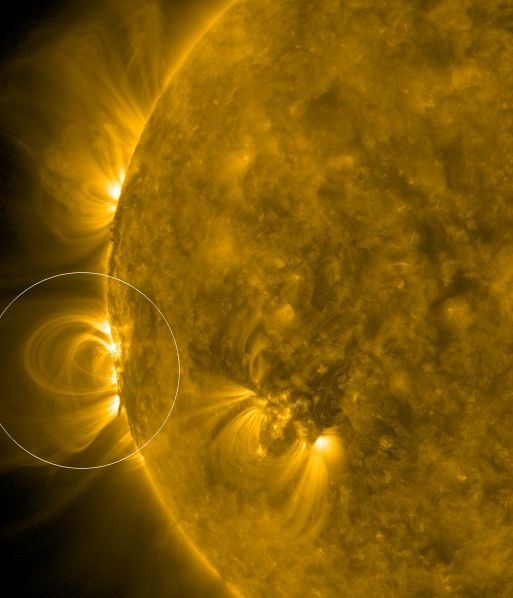
For the past two weeks, AR2673 has been transiting the backside of the sun, carried around by the sun's 27-day rotation. It is due to return in the next day or so. The loops, shown above, trace the AR2673's towering magnetic canopy, coming into view before the sunspot itself. Will it be as potent as before? Probably not, but stay tuned! Realtime Space Weather Photo Gallery SOLAR WIND STREAM APPROACHES EARTH: A hole in the sun's atmosphere is spewing solar wind toward Earth. This image from NASA's Solar Dynamics Observatory shows where solar magnetic fields have parted, allowing the gaseous material to escape: 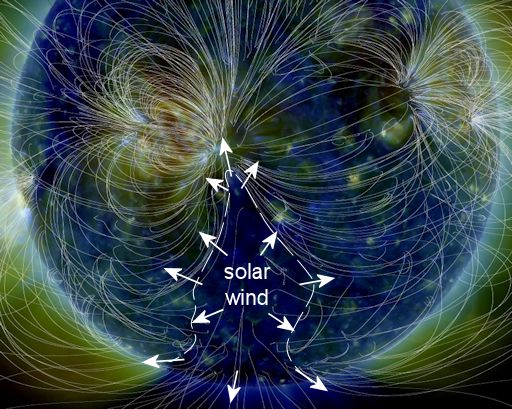
Traveling faster than 600 km/s (1.3 million mph), the leading edge of the solar wind stream is expected to reach our planet on Sept. 24th, bringing a 40% chance of polar geomagnetic storms. The chance of storms rises to 50% on the next day, Sept. 25th, as Earth moves deeper into the stream. Northern sky watchers should be alert for autumn auroras. Free: Aurora Alerts Realtime Aurora Photo Gallery
TOTAL ECLIPSE OF THE HEART PENDANTS: On Aug. 21st during the Great American Solar Eclipse, the students of Earth to Sky Calculus launched 11 space weather balloons from the path of totality. They aimed to photograph the Moon's shadow from the stratosphere--and they succeeded. As a fundraiser, some of the balloons carried jewelry, such as this heart-shaped pendant floating inside the Moon's shadow more than 100,000 feet above Oregon's Malheur National Forest: 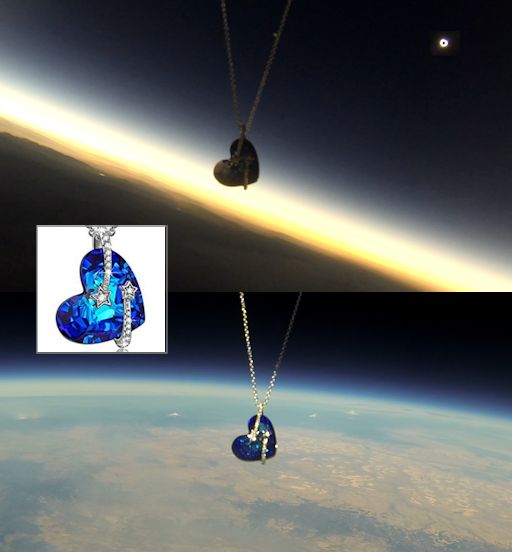
During the 2.5 hour flight, the pendants were wrapped in the Moon's shadow for more than two minutes, experiencing a spooky darkness colder than -50 C. You can have one for $149.95. Each limited-quantity pendant comes with a unique gift card showing the jewelry passing through the Moon's shadow and floating at the top of Earth's atmosphere. The interior of the card tells the story of the flight and confirms that this gift has been to the edge of space and back again. Far Out Gifts: Earth to Sky Store
All proceeds support hands-on STEM education
Every night, a network of NASA all-sky cameras scans the skies above the United States for meteoritic fireballs. Automated software maintained by NASA's Meteoroid Environment Office calculates their orbits, velocity, penetration depth in Earth's atmosphere and many other characteristics. Daily results are presented here on Spaceweather.com. On Sep. 24, 2017, the network reported 66 fireballs.
(66 , 0 sporadics) 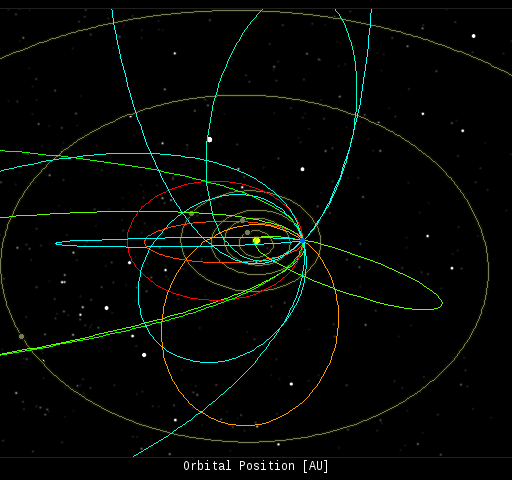 In this diagram of the inner solar system, all of the fireball orbits intersect at a single point--Earth. The orbits are color-coded by velocity, from slow (red) to fast (blue). [Larger image] [movies] Potentially Hazardous Asteroids ( PHAs) are space rocks larger than approximately 100m that can come closer to Earth than 0.05 AU. None of the known PHAs is on a collision course with our planet, although astronomers are finding new ones all the time. On September 24, 2017 there were 1803 potentially hazardous asteroids.  | Recent & Upcoming Earth-asteroid encounters: | Asteroid | Date(UT) | Miss Distance | Velocity (km/s) | Diameter (m) | | 2017 RG2 | 2017-Sep-19 | 7.9 LD | 8.4 | 47 | | 2017 SM2 | 2017-Sep-20 | 0.8 LD | 8.5 | 12 | | 2017 SR2 | 2017-Sep-20 | 0.2 LD | 10 | 7 | | 2017 RQ15 | 2017-Sep-22 | 9.7 LD | 20.4 | 23 | | 2017 RB15 | 2017-Sep-22 | 5.8 LD | 5 | 10 | | 2017 PR25 | 2017-Sep-23 | 17.9 LD | 13.5 | 240 | | 2017 ST10 | 2017-Sep-24 | 2.8 LD | 9.7 | 7 | | 2017 RW2 | 2017-Sep-25 | 15.1 LD | 12.9 | 28 | | 2017 SP10 | 2017-Sep-25 | 12.2 LD | 9.2 | 20 | | 2017 RW1 | 2017-Sep-25 | 11 LD | 12.7 | 65 | | 2017 RO16 | 2017-Sep-25 | 5 LD | 8.2 | 10 | | 2017 RB16 | 2017-Sep-26 | 4.8 LD | 9.5 | 26 | | 2004 SS | 2017-Sep-26 | 15.8 LD | 7.9 | 141 | | 2017 SS10 | 2017-Sep-27 | 10 LD | 11.7 | 32 | | 2017 SQ10 | 2017-Sep-27 | 16.2 LD | 7.4 | 18 | | 1989 VB | 2017-Sep-29 | 7.9 LD | 6.3 | 408 | | 2017 RP15 | 2017-Sep-30 | 14.8 LD | 5.5 | 16 | | 2017 OD69 | 2017-Oct-01 | 13.2 LD | 7.6 | 213 | | 2017 SO10 | 2017-Oct-04 | 16.7 LD | 8.4 | 37 | | 2004 RE84 | 2017-Oct-04 | 15.3 LD | 16.1 | 129 | | 2017 RV1 | 2017-Oct-12 | 17.8 LD | 10.9 | 353 | | 2012 TC4 | 2017-Oct-12 | 0.1 LD | 7.6 | 16 | | 2005 TE49 | 2017-Oct-13 | 8.5 LD | 11.2 | 16 | | 2013 UM9 | 2017-Oct-15 | 17 LD | 7.8 | 39 | | 2006 TU7 | 2017-Oct-18 | 18.7 LD | 13.3 | 148 | | 171576 | 2017-Oct-22 | 5.8 LD | 21.2 | 677 | | 2003 UV11 | 2017-Oct-31 | 15 LD | 24.5 | 447 | | 444584 | 2017-Nov-17 | 8.7 LD | 14.8 | 324 | Notes: LD means "Lunar Distance." 1 LD = 384,401 km, the distance between Earth and the Moon. 1 LD also equals 0.00256 AU. MAG is the visual magnitude of the asteroid on the date of closest approach. | | Cosmic Rays in the Atmosphere |
Readers, thank you for your patience while we continue to develop this new section of Spaceweather.com. We've been working to streamline our data reduction, allowing us to post results from balloon flights much more rapidly, and we have developed a new data product, shown here: 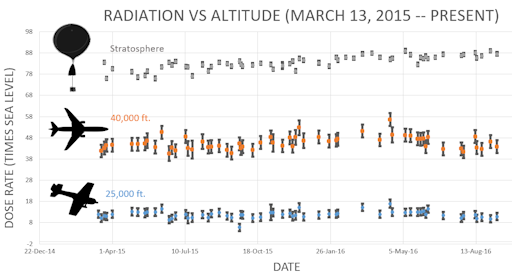
This plot displays radiation measurements not only in the stratosphere, but also at aviation altitudes. Dose rates are expessed as multiples of sea level. For instance, we see that boarding a plane that flies at 25,000 feet exposes passengers to dose rates ~10x higher than sea level. At 40,000 feet, the multiplier is closer to 50x. These measurements are made by our usual cosmic ray payload as it passes through aviation altitudes en route to the stratosphere over California. What is this all about? Approximately once a week, Spaceweather.com and the students of Earth to Sky Calculus fly space weather balloons to the stratosphere over California. These balloons are equipped with radiation sensors that detect cosmic rays, a surprisingly "down to Earth" form of space weather. Cosmic rays can seed clouds, trigger lightning, and penetrate commercial airplanes. Furthermore, there are studies ( #1, #2, #3, #4) linking cosmic rays with cardiac arrhythmias and sudden cardiac death in the general population. Our latest measurements show that cosmic rays are intensifying, with an increase of more than 13% since 2015: 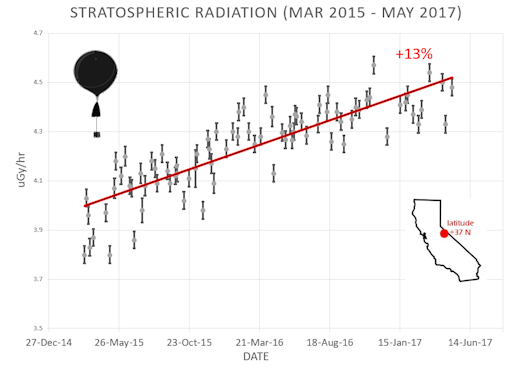
Why are cosmic rays intensifying? The main reason is the sun. Solar storm clouds such as coronal mass ejections (CMEs) sweep aside cosmic rays when they pass by Earth. During Solar Maximum, CMEs are abundant and cosmic rays are held at bay. Now, however, the solar cycle is swinging toward Solar Minimum, allowing cosmic rays to return. Another reason could be the weakening of Earth's magnetic field, which helps protect us from deep-space radiation. The radiation sensors onboard our helium balloons detect X-rays and gamma-rays in the energy range 10 keV to 20 MeV. These energies span the range of medical X-ray machines and airport security scanners. The data points in the graph above correspond to the peak of the Reneger-Pfotzer maximum, which lies about 67,000 feet above central California. When cosmic rays crash into Earth's atmosphere, they produce a spray of secondary particles that is most intense at the entrance to the stratosphere. Physicists Eric Reneger and Georg Pfotzer discovered the maximum using balloons in the 1930s and it is what we are measuring today. | | The official U.S. government space weather bureau | | | The first place to look for information about sundogs, pillars, rainbows and related phenomena. | | | Researchers call it a "Hubble for the sun." SDO is the most advanced solar observatory ever. | | | 3D views of the sun from NASA's Solar and Terrestrial Relations Observatory | | | Realtime and archival images of the Sun from SOHO. | | | from the NOAA Space Environment Center | | | fun to read, but should be taken with a grain of salt! Forecasts looking ahead more than a few days are often wrong. | | | from the NOAA Space Environment Center | | | the underlying science of space weather |  | Reviews here can help you to pick up best memory foam mattresses. | | | These links help Spaceweather.com stay online. Thank you to our supporters! | | | | | | | | |  | |  |   | ©2017 Spaceweather.com. All rights reserved. This site is penned daily by Dr. Tony Phillips. | |

